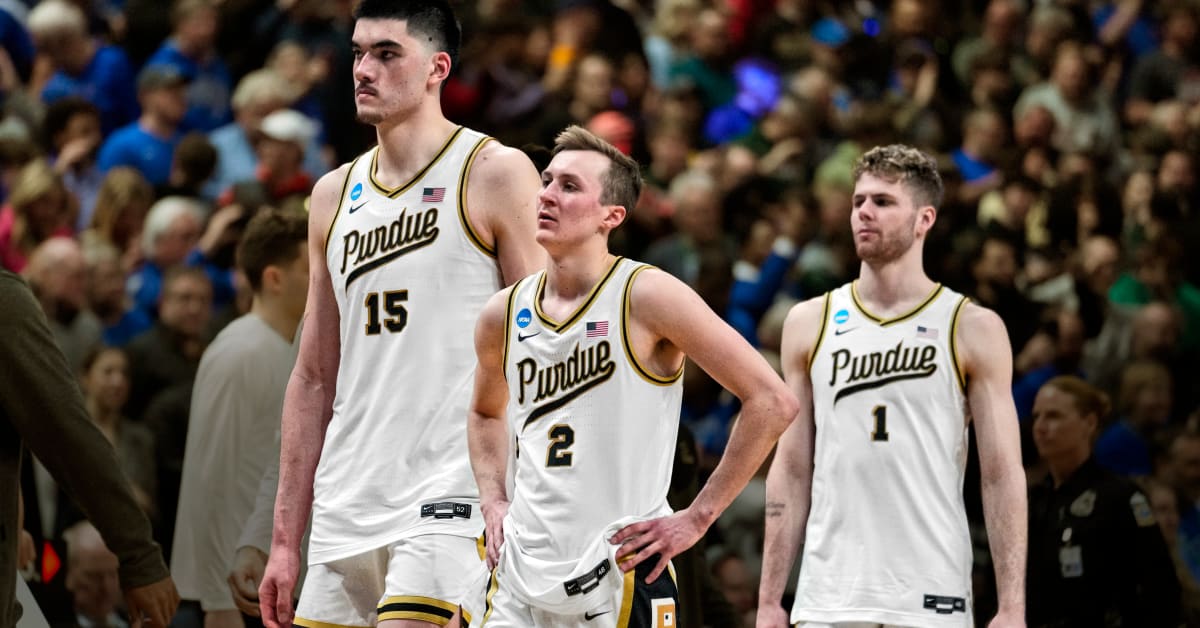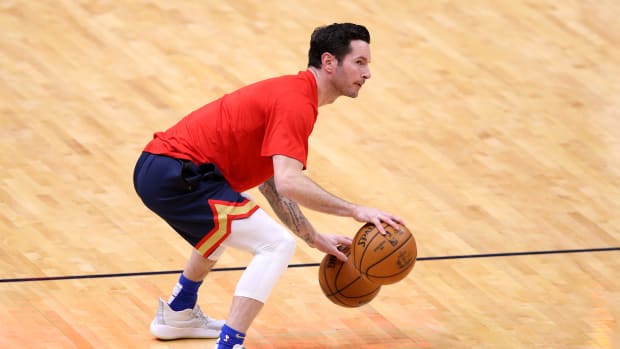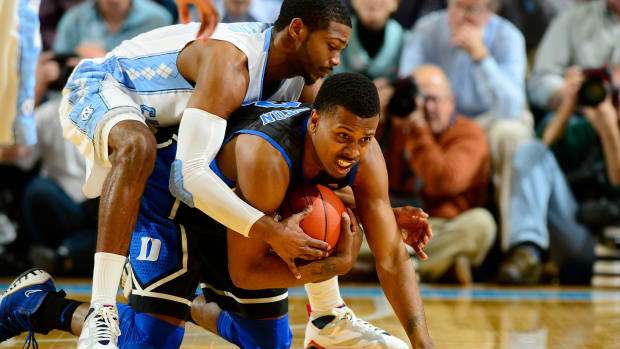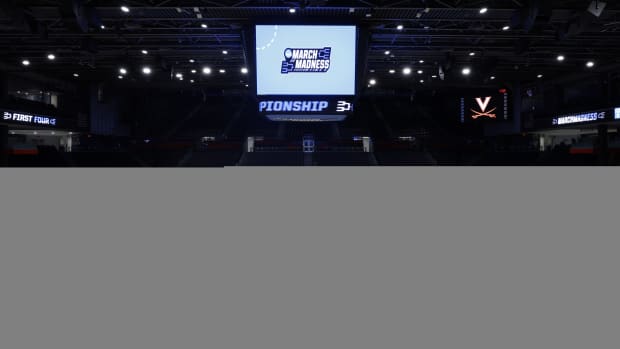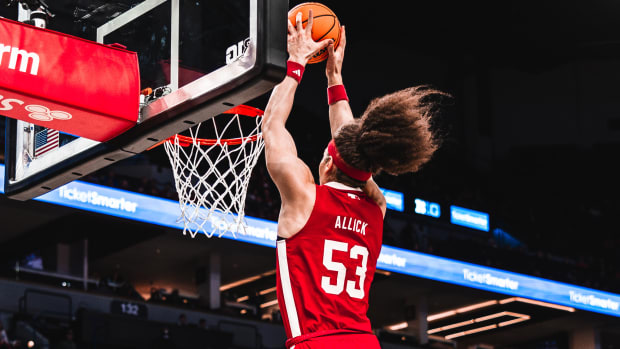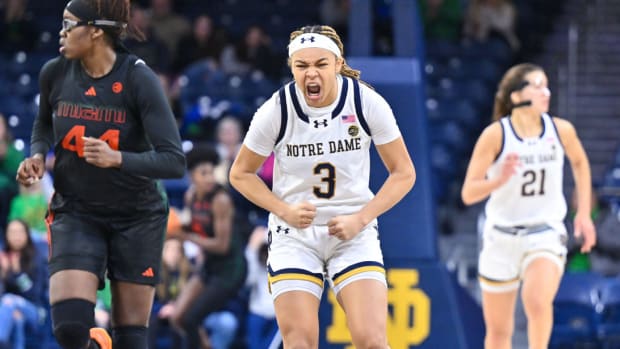Matt Painter could see it in the eyes of his Purdue team as Fairleigh Dickinson’s miracle upset bid started becoming more real. Players started passing up open shots on offense, lacking the self-confidence in that moment to take the shots they’d made thousands of times in empty gyms. Nobody seemed comfortable with the ball in their hands.
Whoa, he doesn’t want it. He doesn’t want anything to do with it, Painter thought to himself.
It was the start of an all-systems failure, one that ended in the No. 1–seed Boilermakers and National Player of the Year Zach Edey falling in the first round of the NCAA tournament—the most shocking March Madness upset ever. There had been some warning signs late in the regular season, but nothing that could have predicted this: a loss to what was at the time the 299th-ranked team in KenPom’s analytics model, the shortest team in Division I and a team in the postseason only because NEC champion Merrimack was ineligible for the NCAA tournament.
Purdue under Painter had been no stranger to March disappointment: Its previous two trips to the Big Dance had ended in losses to No. 13 and No. 15 seeds, respectively, and, despite his sterling regular-season track record, in 18 years at the helm he has never made the Final Four. But this shocking defeat, just the second time a No. 16 had beaten a No. 1 seed, felt particularly cataclysmic, an if not now, when? moment for a Boilermakers fan base yearning for the program to take the next step.
The common thread was clear: Purdue was consistently struggling in March against teams with small, quick guards, while poor three-point shooting in elimination games (5–21 against Saint Peter’s in 2022, 5–26 against FDU in ’23) left the offense sputtering. The knee-jerk reaction would have been wholesale change, perhaps a pivot away from Purdue’s post-up-centric offense or a major shift in roster construction to match the teams beating them.
But while Painter acknowledges the need to get more athletic, there are no plans to rip up the playbook that helped Purdue win the Big Ten regular-season crown by three games a year ago. The Boilermakers are bringing back six of their top seven scorers, headlined by Edey; adding just four newcomers (a rarity in 2023 college basketball); and making minor adjustments, but mostly doubling down on the process that has gotten them to the brink in March with hopes that this year is finally the time for a breakthrough.
Any conversation about Purdue basketball begins with Edey, the 7' 4" behemoth who has taken the school’s love of the big man to a different level. In the last year, the center has experienced remarkable highs (winning the Wooden and Naismith awards, suiting up for his national team at the FIBA World Cup this summer), crushing lows (the FDU loss) and a life-altering decision on whether to head to the NBA draft. Despite being a uniquely unstoppable force in the college game due to his overwhelming size, physicality and touch, much of the narrative surrounding him focuses on what he can’t do, not what he can. Can he defend in space well enough to play at the next level? Can he space the floor? The loss to massively undersized Fairleigh Dickinson, whose tallest starter was 6' 6", only amplified the criticisms.
“I feel like my story has been one of success,” Edey says. “I came into college under-ranked, under-recruited, worked for two years straight behind a really, really good center in Trevion Williams, finally got my starting spot and succeeded, but all they wanna do is tear me down. It’s a little unfortunate how people do that.”
Edey moved in the right direction toward his NBA dream this spring and summer, despite electing to return to school for his senior season. He had a strong performance at his pro day in May, showing off his foot speed and skill level. With the Canadian national team, he played with NBA stars like Shai Gilgeous-Alexander in a style of game more similar to the pros than college. (Edey averaged 3.8 points and 1.4 rebounds per game as Canada finished third at the World Cup.) He told reporters in June that his likely NIL earnings made the money “pretty even” between staying in school and turning pro, so he decided on one last ride with the Boilermakers. It provides him the chance to go out on a high note, rather than that disastrous night against Fairleigh Dickinson being his final collegiate memory.
Watch college basketball with Fubo. Start your free trial today.

Edey averaged 22.3 points and 12.9 boards per game for the Boilermakers last year.
Michael Reaves/Getty Images
“I don’t think I said a word for the next two days [after FDU], just trying to process it, take it in, not lash out, take it in stride,” Edey says. “Eventually you have to accept that it happened and move on. No point living in the past. You have to accept that that’s going to be attached to your name and just move on.”
That’s part of the maturity the 21-year-old possesses. Edey is fiercely competitive but also remarkably self-motivated and self-aware. He often defended his teammates in postgame media sessions last year when they fielded questions about key miscues. He’s more of a lead-by-example player by nature but has worked on becoming more vocal over the summer. Despite the criticism Edey endured after the FDU loss, his mentality is less about proving others wrong and more proving himself right, that he can be great and that he can lead Purdue to places the program has never gone before.
“I’ve never believed that you get motivation from negativity. I think a lot of people say, like, ‘Oh, I’m motivated by my haters.’ I don’t think that’s very good. I don’t think you can sustain that,” Edey says. “You have to be motivated by yourself. You have to be motivated by trying to be great. You have to be motivated by wanting to be the best version of yourself and taking that little step every day.”
There are also reasons to believe that Edey hasn’t reached his ceiling yet. This season will be just his seventh playing organized basketball, as he grew up playing baseball and hockey in Toronto. Painter believes he’ll be a better player in 2023–24 than he was while sweeping the national awards last year, when he averaged 22.3 points and 12.9 rebounds per game, particularly after a summer training and playing with pros that should slow the game down for him when the college season starts. Edey has learned how to better deal with the inconsistency with which he’s officiated and is playing more physically and more confidently than he was a year ago. An even better Edey is as good a reason as any to believe Purdue can turn its previous March woes around.
That said, Purdue didn’t lose to FDU because teams had cracked the code on Edey. Fairleigh Dickinson’s defensive game plan was essentially to make it as difficult as possible for Edey to get his 21 points and dare everyone else on the floor to beat them. The undersized Knights took that to an extreme to win in a high-variance, single-elimination scenario, but teams had increasingly started defending Purdue this way as Edey’s dominance took hold last season. The difference between the other-worldly offense Purdue had in the season’s first three months (when the Boilermakers started 22–1) and the more pedestrian one they had in February and March (which included a stretch of four losses in six games) is that outside shots stopped dropping. Starting point guard Braden Smith shot 44% from three in the first half of the season and 31.4% in the second half. Shooting guard Fletcher Loyer fell off from 36.6% to 26.1%.

Smith made the Big Ten All-Freshman Team after averaging 9.7 points and 4.4 assists last season.
Michael Hickey/Getty Images
“Collectively, we had a slow deterioration [of confidence] at the end of the year to where people just said, like, ‘We’re going to make you step up and make these shots,’ and they weren’t even contested shots,” says Painter, pointing out that the team shot more uncontested threes than any team in college basketball a season ago.
In time, there’s a belief that the numbers will even out. Sophomores Loyer and Smith were elite shooters in high school. Veteran forward Mason Gillis’s percentages dropped to 35.6% last year after shooting 41.4% from deep in 2021–22. Get back to numbers like that, and the Purdue offense will again be the unstoppable tidal wave it was early last season.
There will be changes, though. Outside of Smith’s seven turnovers in the FDU game, he had a remarkably productive freshman season and has more room to grow. Painter is intent on shifting his point guard’s mindset into becoming a more shoot-first player, believing it to be one of the keys to the Boilermakers breaking through in March. Smith won’t be firing up shots like Carsen Edwards once did in a Purdue uniform, but option Nos. 1, 2 and 3 can no longer be feeding the ball to Edey down low.
“He’s a very good passer, but he’s not a great one when he’s thinking pass-first,” Painter says. “He’s great when he’s thinking about scoring, and then they take that away and he makes them pay. Any time they’re going to let him get to the rim, get in the paint, get a rhythm three, he has to make them pay. They’re all high-percentage plays.”
Painter not reshaping the roster much via the portal means the clearest answer to How is this team different? is freshman Myles Colvin. A Purdue legacy, Colvin—whose dad, Roosevelt, played football for the Boilermakers—committed to the school a month before his 16th birthday and has since blossomed into a highly touted four-star recruit. He brings elite athleticism to the table: Video of him soaring through the air for dunks this summer went viral in college basketball circles, and he shot the ball well from three playing with Team USA team at the U19 FIBA World Cup. Athletically, he doesn’t fit the traditional mold at Purdue, a program that has often emphasized smarts over raw physical tools under Painter.

Colvin, a four-star recruit, arrives at Purdue as a second-generation Boilermaker.
Grace Hollars/IndyStar/USA Today Network
“Myles gives us a couple of things that we were lacking in one person,” Painter says. Smith called his athleticism “a huge change” from what the Boilermakers had a season ago.
But Colvin didn’t turn 18 until August. He didn’t play on one of the major summer AAU circuits and stayed home to play at Heritage Christian School in Indianapolis rather than transfer to a prep school playing a more national schedule. How ready Colvin is to contribute at the highest level remains to be seen, but Purdue is relying on him to up the team’s speed and athleticism instead of looking for more transfer reinforcements.
There’s hope that a spring and summer largely without Edey (he spent time away from campus preparing for the draft, then missed the team’s four-game tour of Europe in August while playing for Canada) will help balance out the Boilermakers long term. There’s a certain safety blanket that comes with having an unguardable man on the floor for nearly 32 minutes a game. The rest of the roster learning to play without Edey may help them play with him—Smith getting reps being more assertive without a dominant center, Colvin and Loyer having an even greener light to fire from distance, talented backup center Trey Kaufman-Renn building up confidence.
“We’ve got other guys on this team that are really good,” Smith says of the notion that this team is just Edey, then everyone else.
Plus, the Boilermakers have benefited from continuity. Having five starters back is rare in today’s college game. Doing it after a season as a No. 1 seed? Nearly unheard of. It’s easy to forget Purdue had three new starters (two of whom were freshmen) in 2022–23. The learning curve this summer was different. “Compared to last year, I think we’re a whole lot better,” Smith says.
Fairleigh Dickinson won’t be this season’s rallying cry. No matter how much of an external talking point it continues to be, Purdue’s players insist they’ve turned the page. “It’s just another game” is a frequent refrain, however hard that may be to truly believe. Painter has always preached a mindset of taking care of what’s in front of you, and that attitude still pervades the Boilermakers even after their most stunning defeat.
“[The page] is fully turned,” Smith says. “It’s a big deal. I’m not saying it’s not. But to me, I just see it as another basketball game. People are going to say what they want to say. It’s not like I’m going to change anything just sitting there thinking about it all the time.”

Painter has reached the Sweet 16 six times, but this year may be his best shot at his first Final Four.
Marc Lebryk/USA TODAY Sports
That makes this year’s group the ultimate prove-it team: No amount of ripping through early-season play will convince the college basketball world that this year will be different. Purdue hasn’t lost to a nonconference opponent in the regular season since December 2020, a span of 24 games. It has five more Big Ten wins than the next-closest team in the last five seasons (and that includes a less-than-stellar nine-win conference campaign in ’19–20). Given the program’s tournament track record, this is a March-or-bust season, and with it likely being Edey’s last in West Lafayette, it may just be Painter’s best chance at finally reaching a Final Four and maybe winning it all.
But being a March-or-bust team means living with the reality of seasons defined by single-elimination 40-minute games. The pressure of March broke Purdue last year. And no matter how determined the Boilermakers, who are almost certain to be a high seed again, are to not let that happen again, it’s impossible to know what look Painter will see in his players’ eyes once the ball gets tipped next spring.
